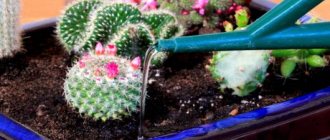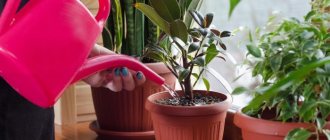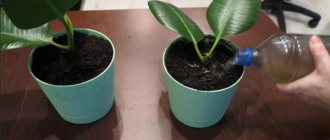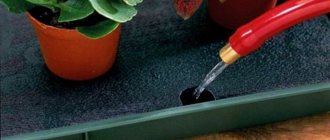Requirements for growing conditions
Saintpaulias or indoor violets are often grown, and gardeners wonder how to water violets correctly and what growing conditions are most suitable for plants. Among the features of growing indoor flowers, you need to consider the following:
- Small pots are used for plants. A spacious flower container stimulates the appearance of leaves, but there will be no buds;
- the soil should be light and well breathable. It is also necessary to pay great attention to drainage. In heavy soil, violets will begin to turn yellow and may die;
- air humidity is high. The air around the plants must be humidified using a spray bottle;
- in summer the plant needs a little shade. Direct sunlight can harm delicate leaves.
The plant also needs regular watering and fertilization. It is necessary to water the bush carefully so that drops do not fall on the leaves.
Important! Inexperienced gardeners often make mistakes and spray water on the plant. This can lead to the appearance of diseases on the surface of the leaf.
How to care for violets: mistakes made by novice gardeners
- You cannot plant a small flower in a large container - the roots of the plant will be too loose. The rosette of the flower should be three times the diameter of the pot.
- You cannot place pots of violets right next to each other. If the leaves of different plants overlap, this will have a negative effect on the growth and development of the flower.
- Violet needs loose soil. Therefore, the soil in the pot needs to be loosened periodically.
- You should not place a pot of violets in a draft, as this will cause red spots to appear on their leaves.
- Observe the plant carefully. The violet may die from excessive watering or lack of moisture.
Proper watering
In order for buds to appear, you need to know how to water violets. The plant prefers warm water that has previously settled. Water must be carefully introduced into the soil under the leaves. After the water has completely saturated the soil, excess liquid from the pan must be removed. Often, excessive moisture leads to rotting of the roots. Therefore, in order to understand how often to water violets at home, it is recommended to take a closer look at the soil. If the top layer of soil is dry, moisture is added. If it is wet, no watering is carried out.
You can also water the plant through a tray. To do this, warm water is poured into the tray and a flower pot is placed. However, using this method, you also need to know how often to water your violets. Watering with this method is carried out no more than once a week. The duration of the procedure is 15-20 minutes, after which excess moisture is removed.
How often
In hot weather, you need to water once every two days. On cold days, watering should be reduced to twice a week.
Moisture consumption increases significantly during flowering. During this period, you need to especially carefully monitor the condition of the soil.
Old plants with extensive root systems also require more moisture than young ones.
Expert opinion Olga Nikolaevna Nesterova Specialist in landscaping, master of landscape design. Indoor floriculture consultant
Observing the flowers will help you adjust the watering schedule. What may be a useful volume for one violet, may be disastrous for another violet, for example, of a different variety.
Observing the plant and the substrate in which it grows will help determine the right moment for watering.
Determining the right moment
A waterlogged substrate is always richly dark in color. If you lift the pot, you will feel its heaviness.
There may be excess moisture in the pan.
Sluggish lower leaves and bent inflorescences in light soil indicate that urgent watering is needed.
This is interesting. The second name of the violet, Saintpaulia, translated from ancient Greek means the flower of love. A love drink was prepared from the leaves of Saintpaulia. Tea with the addition of violet leaves was popular. The leaves were also used as a seasoning for meat.
According to modern beliefs, the flower is considered the guardian of love and ensures the safety and reliability of family ties.
The soil in the pot should always be loose and slightly moist. The consistency is similar to a slightly squeezed sponge, which contains enough water, but it does not drip or run off if the sponge is lying on the table surface.
There is another way to check whether watering is needed. To do this, the index finger of the hand is buried in the ground to the size of the first phalanx. If it remains dry, watering is necessary.
What does frequency depend on?
Watering is influenced by the following factors:
- Ambient temperature. The higher the temperature, the more often watering is needed
- Air humidity. As air humidity increases, watering should be reduced.
- Availability of additional lighting. With additional lighting, the soil dries out faster and therefore requires more frequent moistening.
- Pot size. In a small pot, the soil dries out faster. At the same time, clay pots promote the evaporation of moisture through the pores, while plastic pots concentrate water inside.
- Soil composition. Hard soil holds more moisture for a longer period. Loose contains more oxygen, and water evaporates faster.
- At different periods of its life, violets consume different amounts of water. The greatest consumption occurs at the time of flowering.
Schedule for summer, autumn, winter and spring
The process of photosynthesis and active growth occurs best in the presence of light. This requires a large amount of water.
Therefore, in summer and in the second half of spring, watering is carried out early in the morning before the onset of heat. During periods of moderate temperatures in early spring, autumn and winter, watering can be done at midday.
If you have artificial lighting, you don’t have to adhere to this rule and water in the evening.
In summer, spring and autumn, watering is carried out 3-4 times a week. In winter, the plant begins its resting season. One watering per week will be enough.
It is important to prevent the violet from freezing. Therefore, if there is severe frost in winter, and the flower is located on the window, you need to move it inside the room, where the air is warmer
What is special about watering?
Watering is a mandatory condition that must be observed when growing plants. It is necessary to water the violets not too much. To prevent moisture from accumulating in the soil, watering is carried out no more than once every 2-3 days.
If moisture appears in the pan, watering stops before the soil dries out a little. Otherwise, diseases may appear.
What to do if violets are flooded
If it is noticed in time that the soil in the pot is waterlogged and the flower has just begun to fade, it is necessary to remove the soil lump and dry it completely. In the future, you need to choose a watering regime suitable for the flower.
In case of heavy flooding, the plant should be replanted. If the roots have already begun to rot, then the flower can be saved by growing its “baby” from a cutting.
Did you know? A resident of Odessa (Ukraine) collected in his apartment the largest collection of violets in Europe - 3.5 thousand varieties, including those grown by astronauts in orbit. To water all the specimens, the gardener needs 800 liters of water per week, and he spends $
per month on lighting them. There are 2 more ways to resuscitate flooded flowers:
- Pour in a solution of succinic acid (0.02%);
- Pour in liquid vitamin B12 (1 ampoule/1 liter of water).
Such watering will increase the plant’s immunity, normalize the soil microflora and neutralize toxins.
How to feed the plant for abundant flowering
The question often arises of how often a violet needs to be watered with liquid fertilizers for buds to appear. First of all, it is necessary to understand which element is necessary for plants. If the violet is developing quickly, but there are no buds, this may indicate a large amount of nitrogen. For abundant flowering, the plant must be fed with phosphorus and potassium.
Most often, liquid fertilizers are used, which are mixed with water. How often to water indoor violets with fertilizers depends on the method of applying the substance:
Root method
For abundant flowering, you need to know how many times to water the violet with fertilizer. For frequent watering, you need to add a small amount of fertilizer to the water. For frequent feeding, use 5 parts of the dosage and dissolve in water. The advantage of this fertilizer is the gradual introduction of nutrients, thanks to which the flower actively blooms and grows.
If this method is not suitable, you can feed the plant every 10-15 days. For this purpose, special fertilizers are used. Fertilizer is mixed with water and applied to the root area.
Leaf method
In order to feed indoor violets, the fertilizer is dissolved in warm water and the bush is sprayed with a spray bottle. The frequency of such treatment is no more than once every 2 weeks.
Nutrient components penetrate the leaf plate and saturate the bush with the necessary nutrients.
Propagation of violets by cuttings and stepsons
Cuttings can be taken from a middle-aged plant.
Suitable for cuttings are leaves of the second row, which measure from 3 cm in length. The planting material is carefully cut off with a sharp knife. The cutting can be placed in water with a dissolved activated carbon tablet. Once the cuttings have roots, the plant can be transplanted into a pot. The cuttings can be immediately planted in a pot with soil. In this case, the violet needs to be covered with a plastic bag. Another way to propagate violets is by pinching. Using a sharp knife, carefully cut off the daughter violet. The transplanted plant must have at least 3 full leaves.
How can you water violets?
In order for the plant to bloom, you need not only to know how to properly water violets at home, but also the type of fertilizer to feed.
Homemade products for fertilizing plants
At home, you can use the following products that can be found in almost any kitchen.
- Black tea. To ensure that the soil is not affected by fungi and retains moisture for a long period, it is necessary to mix a small amount of tea with the soil. However, when using such fertilizer, you need to know how often to water the violets. If moistened too often, the tea may clump and interfere with the development of the violet;
- yeast. To stimulate buds, it is necessary to water the bushes with a yeast solution. To do this, you need to prepare 5 liters of warm water and add a tablespoon of dry yeast and 2 tablespoons of sugar. Thoroughly dissolve all ingredients. Leave for several hours to ferment, and carefully feed the indoor violets;
- sugar, the most popular product for feeding. To apply fertilizer, you need to use 1 spoon of sugar per 1 liter and stir the solution thoroughly. Water the soil generously. In order to find out how often it is necessary to water indoor violets with a sugar solution, you need to examine the condition of the bush. For weak bushes, watering is carried out every 15 days. To stimulate flowering, water the bushes once a month.
Properly selected fertilizer can not only stimulate flowering, but also improve the appearance of the bush.
Ready-made drugs
If you don’t have time to prepare fertilizer for feeding, you can use ready-made preparations. The most popular include:
- Uniflor-bud;
- Ambulance;
- Station wagon;
- Ideal;
- Effect.
Each type of fertilizer has detailed recommendations that must be followed.
Lighting
Violets are tender and heat-loving plants. Caring for violets at home requires having enough light. If you do not have well-lit places in your house, it is better not to plant violet flowers, since the growth and flowering of Saintpaulia depends on the quantity and quality of lighting.
If you have a lot of windows, choose an area in your home that has the most indirect soft light. Violets should be placed on a southern windowsill with caution, as they do not like direct sunlight, so on a southern windowsill you need to shade them: cover the window to the height of the flowers' growth with curtains.
If you spend a lot of time in the kitchen, you can also place flowerpots with Saintpaulias there. Firstly, their presence will make you feel comfortable, and secondly, violets like high humidity and good light in the kitchen.
- Abutilon - care, photos, types
If your house violets don't get enough light, they may look pale and lethargic. The leaves will stretch upward, the stalk will lengthen, which means the harmonious shape of the rosette will be disrupted.
In winter, for violets in the evening, it would be a good idea to illuminate the flowers with fluorescent lamps, because for violets the daylight hours should last 13-14 hours.
Useful expert advice for abundant flowering
In order for the violet to bloom profusely, you need to follow some useful tips. These include:
- In order for the violet to bloom regularly, you should not only apply fertilizers, but also create optimal conditions for the growth of the plant;
- Immediately after the bush fades, it is necessary to apply fertilizer. This will contribute to the accumulation of strength and the formation of new buds;
- the plant should be warm;
- Fertilizers must be alternated. Excessive use of organic and mineral nutrients can kill the plant;
- Before watering the soil, you need to loosen it a little. This will stimulate rapid penetration of nutrients to the roots.
In order for Saintpaulias to bloom, after transplanting the bushes must be fed with complex fertilizers.
Features of the flower
Violet, or Saintpaulia, is a guest from hot Africa, so the plant has the following characteristic features:
- does not tolerate cold;
- drought is an enemy for such flowers;
- overwatering can also kill plants;
- if moisture gets into the middle of the flower, Saintpaulia may begin to rot.
By what signs can you understand that a violet needs to be watered? There are several of them.
- The substrate in the pot became light, and small cracks appeared on its surface.
- The leaves of the plant withered and drooped.
Signs of overwatering are:
- the lower leaves of the plant began to wither and fall off;
- the substrate is moist, dark;
- A large amount of liquid accumulates in the pan.
This information will help gardeners understand the needs of green pets and water violets correctly.
22
How to stimulate violet flowering depending on the time of year
Violet, like any plant, can be in rest mode. During this period, the plant develops poorly and does not form flower stalks.
Winter
In winter, the plant rarely blooms and often forms weak peduncles. During this period, it is recommended to send the plant for wintering. The flower stalks break off and the plant is fed with complex substances.
Summer
In summer, the plant may suffer from elevated temperatures. In order for the indoor violet to produce a peduncle, it is necessary to water every 2 days. Also, the bushes need to be shaded, and phosphorus nutrients must be used as fertilizers.
Spring
The period when it is necessary to transplant the bushes into a new container. Violets bloom profusely, but in order for the buds to be large, it is necessary to water the plants with warm water and add fertilizer.
Autumn
In autumn, violet blooms profusely. However, in order for the bush to regularly set inflorescences, it is necessary to maintain regular watering and apply fertilizer every 15 days.
The abundant flowering of violets allows you to decorate any room. However, in order for the bushes to please with an attractive appearance, you need to know how to water violets at home and what fertilizers should be used. Failure to follow simple recommendations can lead to the death of the flower or a prolonged absence of buds.
Tips regarding water
The quality of tap water leaves much to be desired. It contains a large amount of metal salts, free elements and chlorine, which is dangerous for indoor flowers. You cannot immediately use liquid poured from the tap; it must first be “softened” and heated (the best water temperature for violets is considered to be around +40 °C). For cleaning use:
- freezing - during the day and subsequent defrosting;
- settling - for several hours in an open container (to evaporate volatile components);
- boiling - no more than a minute with the addition of a pinch of citric acid.
Special cases
After transplanting, the violet also needs to be properly watered. Flower growers recommend doing this:
- prepare a pot in advance, the soil in which must be moderately moistened (this is easy to determine: the soil should not stick to your hands);
- the plant that will be transplanted in the morning is watered in advance in the evening;
- after transplanting into a new pot, do not water the flower; you must wait 1-2 days until the surface of the soil dries;
- After this, watering is carried out in the usual way.
Important!
The plant cannot be replanted in dry soil; there is a high risk of damaging the roots.
If the plant is accidentally flooded, it can be saved.
- You need to remove the violet from the pot and inspect the roots. If they are healthy and not blackened, you should wrap them in a paper towel and let them dry.
- Next, the plant is transplanted into new soil (you can also use the old substrate, after drying it).
- Do not water the flower until the soil layer becomes lighter, that is, dries out by 2-3 cm.
Advice
Old soil should not be used if it smells musty.











